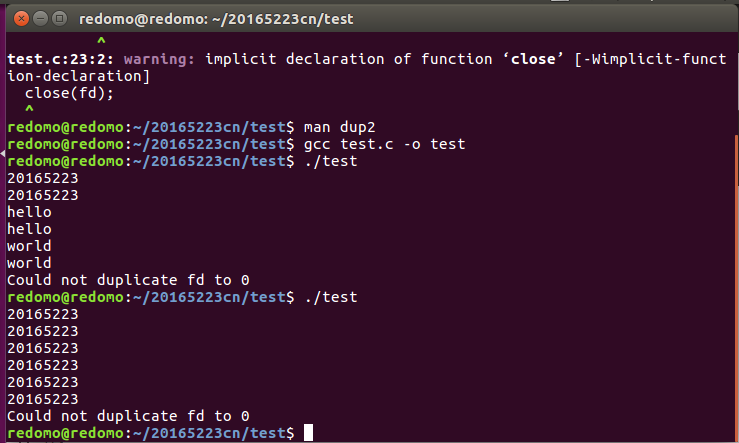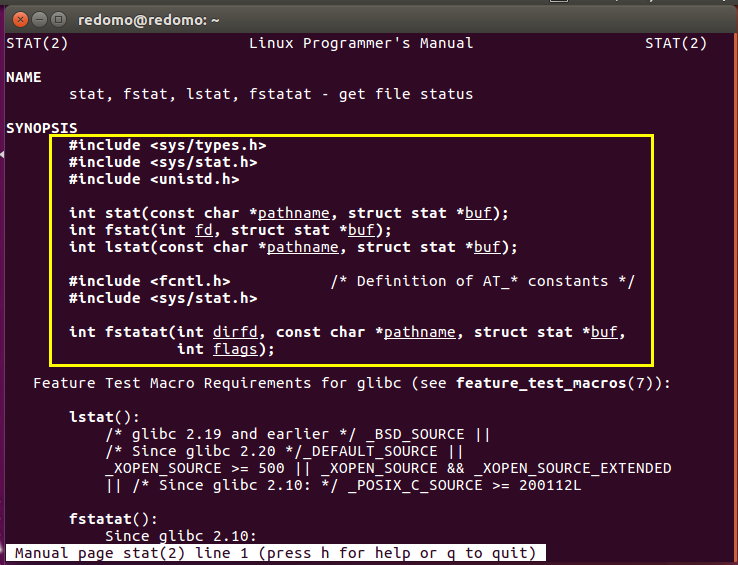#
### [1. 提交学习 stat(1) 的截图](#1) ### [2. man -k ,grep -r的使用](#2) ### [3. 编写mystate.c的伪代码](#3) ### [4. 产品代码 mystate.c,提交码云链接](#4) ### [5. 测试代码,mystat 与 stat(1) 对比,提交截图](#5)
一、学习 stat 命令
1. stat 命令了解
- 作用:用来显示文件的详细信息,包括inode, atime, mtime, ctime
- 格式:stat [OPTION]…FILE…
2. stat 命令格式
- -L:显示符号链接
- -f:显示文件所在的文件系统信息
- -t:以简洁的方式输出摘要信息
3. stat 命令使用实例
-
查看文件的详细信息:stat /文件目录

-
查看文件系统的详细信息:stat -f /文件目录

-
-t查看简洁输出(脚本中常用来获取想要的信息):stat -t /文件目录

-
八进制文件权限(shell脚本时会用到):stat -c "%a" /文件目录

-
查看硬盘的信息:stat /dev/sda

4. stat 输出内容
- File:显示文件名
- Size:显示文件大小
- Blocks:文件使用的数据块总数
- IO Block:IO块大小
- regular file:文件类型(常规文件)
- Device:设备编号
- Inode:Inode号
- Links:链接数
- Access:文件的权限
- Gid、Uid:文件所有权的Gid和Uid
5. Linux下的三个时间
- Access Time:简写为atime,表示文件的访问时间。当文件内容被访问时,更新这个时间
- Modify Time:简写为mtime,表示文件内容的修改时间,当文件的数据内容被修改时,更新这个时间
- Change Time:简写为ctime,表示文件的状态时间,当文件的状态被修改时,更新这个时间
二、实现 mystat
1. 提交学习 stat(1) 的截图
- 使用命令 man 1 stat 查看
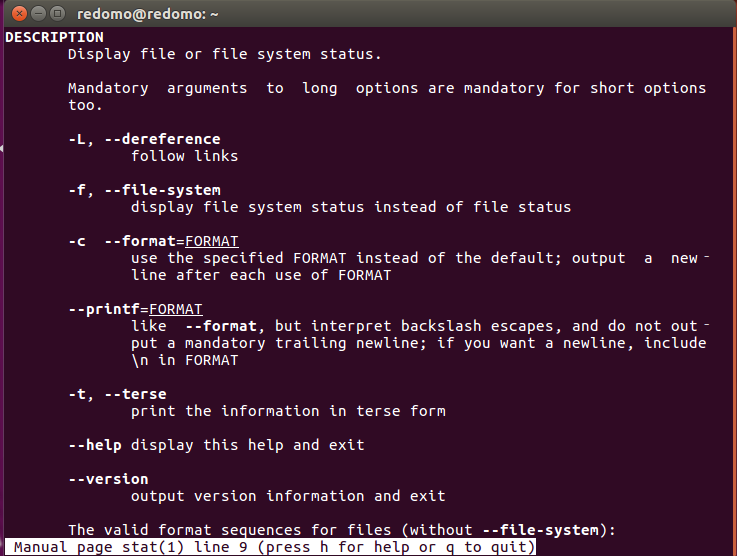
2. man -k ,grep -r的使用
- 使用 man -k stat | grep 2 查找stat相关函数
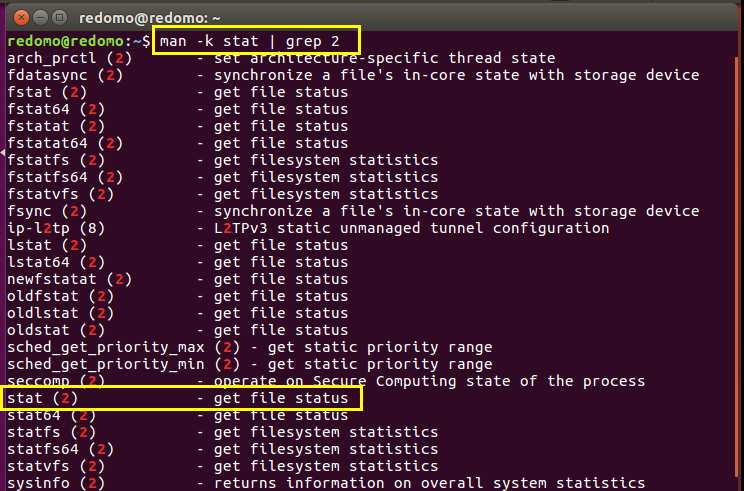
- 使用 man 2 stat 学习函数
3. 编写mystate.c的伪代码
- 用户运行 mystat.c 程序,输入文件名
- 由man 2 stat函数学习后可知调用stat函数实现功能
- 结构体struct stat:
struct stat {
dev_t st_dev; //文件的设备编号
ino_t st_ino; //节点
mode_t st_mode; //文件的类型和存取的权限
nlink_t st_nlink; //连到该文件的硬连接数目,刚建立的文件值为1
uid_t st_uid; //用户ID
gid_t st_gid; //组ID
dev_t st_rdev; //(设备类型)若此文件为设备文件,则为其设备编号
off_t st_size; //文件字节数(文件大小)
unsigned long st_blksize; //块大小(文件系统的I/O 缓冲区大小)
unsigned long st_blocks; //块数
time_t st_atime; //最后一次访问时间
time_t st_mtime; //最后一次修改时间
time_t st_ctime; //最后一次改变时间(指属性)
};
- 依次调用函数,打印输出节点ino,文件类型mode,文件的连接数nlink,用户ID uid和组ID gid,块大小blksize,字节数size,块数目blocks,以及三个时间atime、mtime、ctime
4. 产品代码 mystate.c,提交码云链接
- 产品代码(有参考) mystat.c
#include <sys/types.h>
#include <sys/stat.h>
#include <time.h>
#include <stdio.h>
#include <stdlib.h>
int main(int argc, char *argv[])
{
struct stat sb;
if (argc != 2) {
fprintf(stderr, "Usage: %s <pathname>
", argv[0]);
exit(EXIT_FAILURE);
}
if (stat(argv[1], &sb) == -1) {
perror("stat");
exit(EXIT_FAILURE);
}
printf("File type: ");
switch (sb.st_mode & S_IFMT) {
case S_IFBLK: printf("block device
");
break;
case S_IFCHR: printf("character device
");
break;
case S_IFDIR: printf("directory
");
break;
case S_IFIFO: printf("FIFO/pipe
");
break;
case S_IFLNK: printf("symlink
");
break;
case S_IFREG: printf("regular file
");
break;
case S_IFSOCK: printf("socket
");
break;
default: printf("unknown?
");
break;
}
printf("I-node number: %ld
", (long) sb.st_ino);
printf("Mode: %lo (octal)
",(unsigned long) sb.st_mode);
printf("Link count: %ld
", (long) sb.st_nlink);
printf("Ownership: UID=%ld GID=%ld
",(long) sb.st_uid, (long) sb.st_gid);
printf("Preferred I/O block size: %ld bytes
",(long) sb.st_blksize);
printf("File size: %lld bytes
",(long long) sb.st_size);
printf("Blocks allocated: %lld
",(long long) sb.st_blocks);
printf("Last status change: %s", ctime(&sb.st_ctime));
printf("Last file access: %s", ctime(&sb.st_atime));
printf("Last file modification: %s", ctime(&sb.st_mtime));
exit(EXIT_SUCCESS);
}
- 编译运行 mystat

5. 测试代码,mystat 与 stat(1) 对比,提交截图
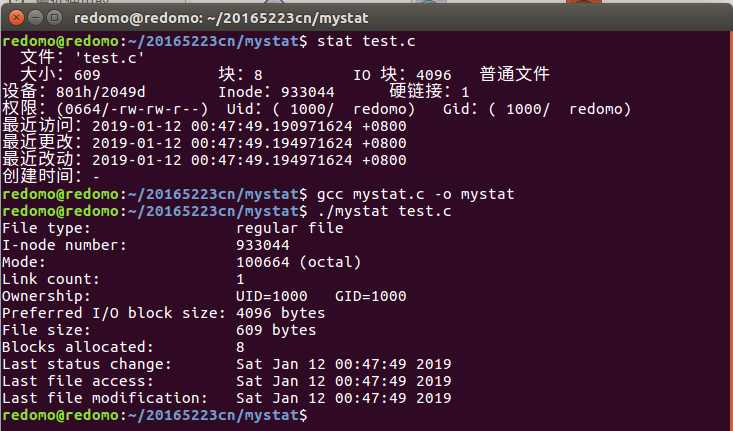
#
### [1. 理解test.c, 说出程序功能](#6) ### [2. 编译运行程序,提交运行截图](#7)
1. 理解test.c, 说出程序功能
- 代码 test.c
#include <stdio.h>
#include <stdlib.h>
#include <fcntl.h>
#include <unistd.h>
int main()
{
int fd ;
int newfd;
char line[100];
fgets( line, 100, stdin ); printf("%s", line );
fgets( line, 100, stdin ); printf("%s", line );
fgets( line, 100, stdin ); printf("%s", line );
fd = open("data", O_RDONLY);
newfd = dup2(fd,0);
if ( newfd != 0 ){
fprintf(stderr,"Could not duplicate fd to 0
");
exit(1);
}
close(fd);
fgets( line, 100, stdin ); printf("%s", line );
fgets( line, 100, stdin ); printf("%s", line );
fgets( line, 100, stdin ); printf("%s", line );
}
- data 内容
20165223cn
hello world
test
- 理解 test.c 功能
- 采集用户的三次输入内容,并打印出来
- 用只读方式打开data文件,并记为fd
- 用newfd复制fd中的内容,并打印出来;若失败则提示"Could not duplicate fd to 0"(不能复制fd)
2. 编译运行程序,提交运行截图
- 编译运行成功

- 复制fd失败时提示错误
